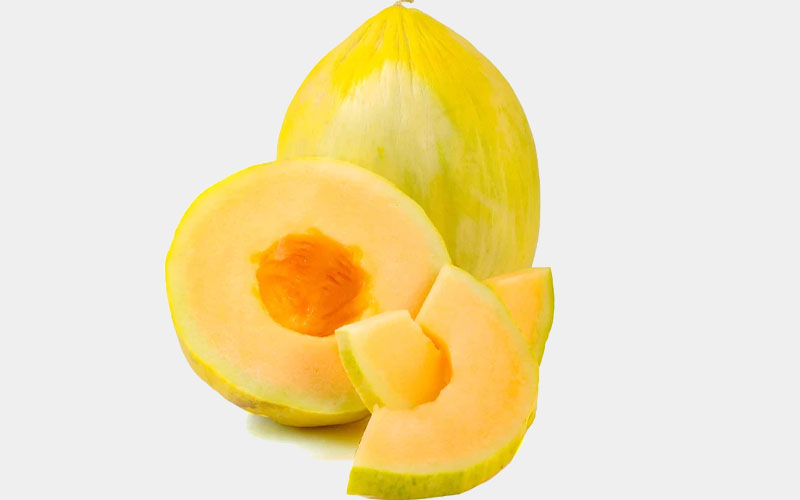How many types of melon have you eaten yet?
More than one for sure.
The interesting thing is that most of the melons we heard or enjoy eating today are hybrid or cross between two different melons.
There is one such pricey melon, that’s called the Cadillac of all the melons for its extra sweetness and aroma.
And that’s none other than Crenshaw melon. So, let’s find more about this beautiful melon today.
Table of Contents
What is a Crenshaw melon?

Crenshaw melon is a cross between a Persian and casaba melons, oblong-shaped with an almost flat bottom on which it can rest vertically.
The rind is firm yellowish-green to golden-yellow with wrinkles at the stem end and slightly waxy feel. Its flesh is peach-colored that is very sweet and aromatic.
Crenshaw melon size is bigger than other members of its genus. Typical Crenshaw melon weighs about 8-10 pounds.
There are two types of Crenshaw melon varieties, green and the sun-burn resistant, white one.
Nutritional Benefits
1 serving=134g
Vitamin A’s minimum daily requirement is fulfilled with a half-cup serving,
9 grams carbohydrates
And most importantly,
Provides 50% of vitamin C’s minimum daily intake, which is a well-known immune-boosting vitamin
Ideally, Crenshaw melon should be paired with cottage cheese to make a balanced meal.
Or as a supplementary dish along with your normal breakfast.
Health Benefits of Crenshaw Melon
Crenshaw melon has a lot of health benefits. Let’s discuss some of them.
i. Boosts Your Immune System
Being rich in vitamin C, Crenshaw melon can help you boost your immunity so that you are less prone to viral diseases.
Since our body can’t store vitamin C, you must make food like Crenshaw melon part of your regular diet so that your body takes what it needs daily.
ii. Helps in the growth and repair of Tissues
The fact that Crenshaw melon contains more than 50% of the daily intake of vitamin C makes it everyone’s favorite.
Eating Crenshaw melon regularly will help your body repair and maintain bones, teeth, and cartilage.
Vitamin C is also helpful in the formation of an important protein used to make tendons, ligaments, blood vessels, and ligaments.
In addition to that, it also aids in the absorption of iron, heals wounds, and form scar tissue.
iii. May Help Maintain A Healthy vision
The Vitamin A content in the Crenshaw melon is helpful in the prevention of night blindness and slows the decaying of eyes according to age.
The good thing is, for this benefit of healthy vision, you need no eat Crenshaw melon frequently.
Instead, vitamin A is a fat-soluble vitamin that can be stored by your body to be used as sand when needed.
iv. May prevent against certain cancers
High intake of vitamin A, especially from plants, is said to reduce the risk of cancer, including Hodgkin’s lymphoma, lung, bladder, and cervical cancer.
Classification of Different Melons
Although most melons are classified as Cucumis melo (Muskmelon), still there are different classifications according to Botany, as follows:
1. Cantaloupensis. Examples include Cantaloupes, which are not common in the US. They have a hard, scaly, and warty rind.
2. Reticulatus. Aromatic melons, like muskmelons and Persian melons, fall in this category.
3. Inodorous. All late-maturing melons, including the variety under discussion today, the Crenshaw melon, its parent, Casabas, fall here. Other varieties include honeydew.
4. Flexuosus. This division Includes varieties such as Snake melon.
5. Conomon. Big cucumber-like melons fall under this category, like Oriental Pickling melon.
How to Grow Crenshaw Melon At Home?
For outdoor planting, sow six seeds per hill, ½ inch deep into the garden, 1-2 weeks after the last frost, and don’t forget to keep a distance of 4-6 feet apart.
Make sure the soils remain warm, especially till the melon reaches the tennis ball size, at least.
For detail, let’s look at each aspect of growing the Crenshaw melon below.
If you’re a novice in gardening, it’s better to get an overview of a few gardening tips first.
1. Preparing the Soil
The first step is the selection of the place and soil quality. The place should receive partial to full sunlight because it grows well in full sunlight.
The use of tools is also an art. So, where possible, try using suitable tools for gardening, so that your work efficiency increases.
The soil should be well-drained with a pH of 6.5 to 7.5. Keep it moist until the germinations start, and the fruit reaches a tennis ball’s size.
The soil temperate should be as high as 75, otherwise cover it with an opaque plastic for a few days until the required temperature is obtained.
2. Sowing the Seeds
For planting Crenshaw melons in your backyard, the right time is two weeks after the last frost happened. Sow 5-6 seeds at one spot and another set 4-6 feet away in the same row.
On the other hand, if you wish to grow it indoors, it’s recommended to plant it 2-3 weeks before the last frost. Sow 2-3 seeds per pot and keep the soil warm.
3. Maintenance
Keep the soil moist until the fruit reaches a large size, as the plant can’t tolerate drought. Nor should you overwater it, which can affect the taste of the fruit later.
To prevent Crenshaw melon from the insect attack, there are a number of methods to choose from.
You may wrap the melon in your kitchen towel, an old T-shirt, or a plastic container to prevent it from rodents or pest attack.
4. Harvesting: When to Pick Crenshaw Melon?
How to tell if Crenshaw melon is ripe? Well, like all other melons, there are certain indications that tell you the right time to pick them.
The first thing is its smell and color. If it has gained that golden-yellowish color and smells too much, it means it has ripened.
Another thing you can do is to look it from the blossom end. Press gently around that end and see if it’s not hard. If it isn’t hard, it’s ripened.
You may also shake it a bit near your ear and listen if you can hear the sound of the pulp. The sound of the shaking pulp may indicate that the fruit has ripened.
The above criteria can be applied while buying this melon from the market too.
Most people, often ask how to tell if a cantaloupe is ripe.
5. Saving Crenshaw Melon Seeds

It’s pertinent to note here that since Crenshaw melon is a hybrid, saving and sowing its seeds may not get you the same melons.
However, if you are not keen about getting the same Crenshaw melon again, here is how you save its seeds.
Saving seeds is one of the easiest things to do.
Once you cut half the melon, remove the whole pulp containing the seeds with a spoon and soak this pulp in water for 2-4 days. The soaking let the dead seeds float on the surface.
Remove these floating seeds and filter the rest of them from the pulp. Now dry these healthy seeds on to a paper towel for 3-4 days.
Once completely dried, put them in a plastic bag and label it with the date of harvest and put it in the freezer for two days, after which place it in the refrigerator.
Recipe: Minted Crenshaw Melon Salad

Due to its extra sweetness, people love to try different Crenshaw melon recipes.
Today, we have brought one such recipe for you, that’s equally tasty and healthy.
Ingredients
- Half Crenshaw melon sliced into small pieces
- About 250g watermelon slices
- 8-10 mint leaves
- 1 tablespoon cane sugar
- 2 tablespoon lime juice
Instructions
Grind cane sugar and mint leaves and add the lime juice. Once a paste is formed, pour it over the slices of Crenshaw and watermelons. The delicious Minted Crenshaw melon is ready.
Different Ways to Eat Crenshaw Melon
- As an evening snack
- Cut with a slicer and add with other fruits to make a fruit salad
- In cold fruit soups
- In salsas, sorbets, and smoothies
- Related: Must-Have Kitchen Items
Can Dogs Eat Crenshaw Melon?
As per AKC, cantaloupes are safe for pups and considered healthy, especially if your dog is overweight.
Even Crenshaw melon seeds are healthy for dogs too, but you should avoid giving them because there’s a risk of choking hazard.
The Bottom Line
Among various melon varieties available, Crenshaw is a must-try hybrid melon, which is the sweetest of all. You can easily grow it in your backyard with minimal care. So, try this beautiful melon, save its seeds, grow next time, and keep enjoying it every season.
Did you know about this melon before? Let us know in the comment section below.


The netted-skinned melon shown here is a muskmelon (true cantaloupe are rarely grown in the USA), not a Crenshaw melon, which have a wrinkly green (ripening to green-yellow) skin.
Muskmelon are harvested when a gentle pull of the vine detaches it from the melon (the skin will also have changed from green to yellowish). I am not sure yet how to determine when crenshaws are harvested since this is my first year growing them. I assume the skin will turn yellow and then the vine will detach.
Oh! Our bad. We have changed the images now. Thanks for identifying, Mark. And Good luck with your melon harvest. Thumbs up!
Crenshaw melons are hybrids, as mentioned in the article. The seeds saved from a hybrid will not grow the same melon. You must plant new seeds every year to get a Crenshaw melon, not seeds from the melon itself.
Thanks for identifying, Nancy. Our apologies for the mistake. The said information has been extracted, and the rest is modified accordingly. Please have a look now.